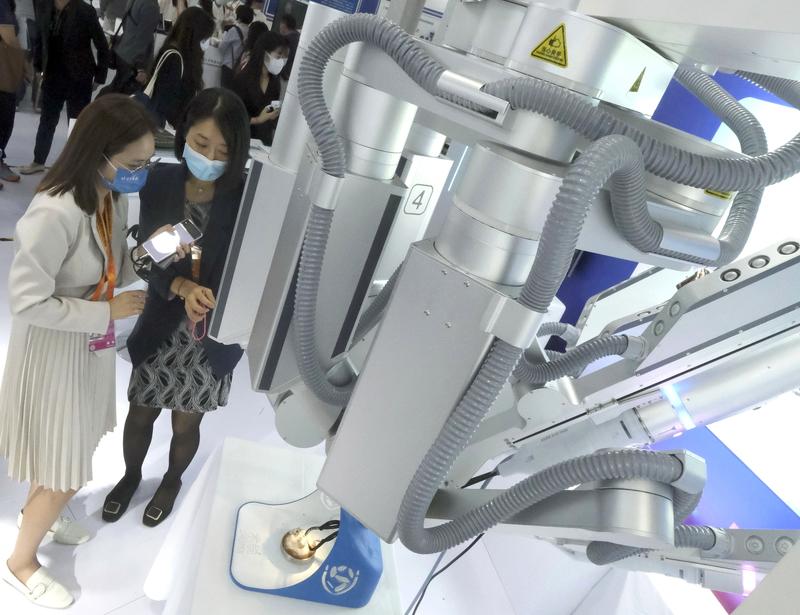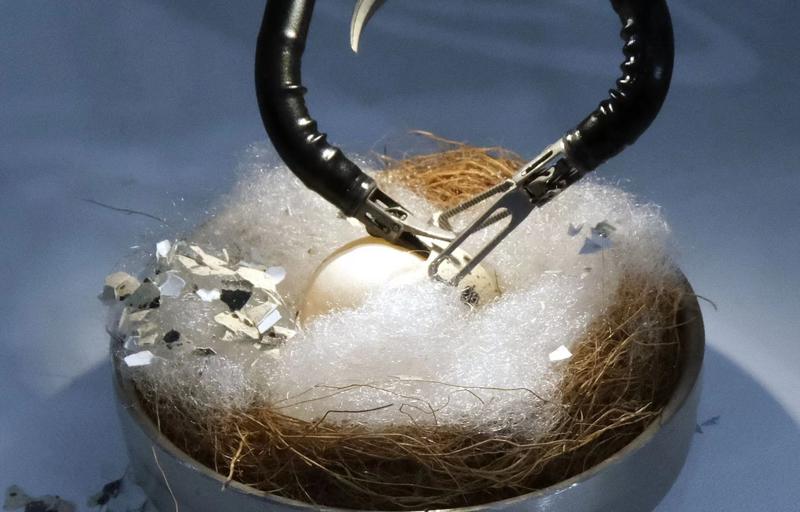 An employee (right) addresses queries on medical equipment during the China International Fair for Trade in Services in Beijing on Friday. (ZOU HONG / CHINA DAILY)
An employee (right) addresses queries on medical equipment during the China International Fair for Trade in Services in Beijing on Friday. (ZOU HONG / CHINA DAILY)
The recently concluded 2022 China International Fair for Trade in Services, or CIFTIS, offered great new opportunities for China's high-end medical device makers, boosting the sector's development, industry experts said.
At a booth during the fair, a pair of curious instruments shaped like syringes attracted many visitors. The instruments can accurately collect tiny amounts of liquid from the eye, and penetrate the sclera to a depth of only about 1 millimeter for precise injection into a specific area of the choroid-the layer between the retina and sclera.
CIFTIS creates new business opportunities for global trade in services, and offers a platform for the accomplishment of scientific and technological achievements.
Xia Chaoran, founder of Sightnovo, a medical technology company
The medical device is the latest achievement of Beijing-based medical technology company Sightnovo in cooperation with Peking Union Medical College Hospital (PUMCH). It allows for micronprecise positioning during surgeries in the suprachoroidal space, providing a safer option for precise drug delivery and minimally invasive interventional therapy. "With these devices, we can derive a whole new diagnosis and treatment system for eye diseases," said Xia Chaoran, founder of Sightnovo.
Suprachoroidal space injection precisely delivers drugs to specific layers of the eye, and avoids side effects caused by normal drug delivery methods. But the method is still underused, as the thickness of the sclera is only around 1 mm, and accurately piercing through the thin layer of dense tissue without damaging the choroid and retina layers underneath, which are only a few tenths of 1 mm thick, is a long-standing problem. The medical devices presented at the fair are seen as key to removing the industry bottleneck.
"CIFTIS creates new business opportunities for global trade in services, and offers a platform for the accomplishment of scientific and technological achievements. The fair deepens our communication with industry peers, and widens possibilities of product integration and innovation," Xia said.
 A smart surgery robot is displayed during the CIFTIS in Beijing on Friday. (ZOU HONG / CHINA DAILY)
A smart surgery robot is displayed during the CIFTIS in Beijing on Friday. (ZOU HONG / CHINA DAILY)
"It provides a deeper understanding of the Chinese healthcare industry's innovation demands, and has anchored the high-quality development of the domestic medical system through scientific and technological innovation," he added.
Other exhibits at the fair included a completely peeled, smooth-skinned quail egg. The shell of the quail egg, which is thin yet crisp and brittle, was peeled by a Chinese-developed surgical robot. Also demonstrating the combination of healthcare and engineering was the minimally invasive surgical robot developed by PUMCH. It can enter the human body through a single incision and conduct surgeries with reduced scarring and speedier postoperative recovery.
Chen Jia, an independent researcher in international strategy, said: "Through the promotion of new application scenarios, China-developed high-end precision medical instruments are gaining popularity. This is of great commercial significance to both current and potential market cultivation."
"Past experience has proved that after CIFTIS, a lot of investments and agreements related to high-end technology are made. In the context of precision epidemic prevention and control, high-end medical device companies are gaining greater commercial exposure, winning potential investment opportunities and business partners, and exploring broader markets," he said.
This year's healthcare-themed exhibition, with an area of 7,700 square meters, was 16 percent bigger than last year. The exhibition hosts numerous high-end medical device companies and healthcare product and service providers, among which Fortune Global 500 companies and other industry leaders constitute over 31 percent. During the fair, 78 agreements were made, 24 involving innovative product launches.
China's medical device industry has seen rapid growth in the past five years. According to research company Askci Corp, between 2017 and 2021, the industry grew from 443.5 billion yuan ($63.9 billion) to 964 billion yuan, with a compound annual growth rate of 21.47 percent. It is estimated that the market will reach 1.17 trillion yuan by the end of this year.
In 2020, the market volume of high-end medical devices increased by 19.5 percent year-onyear to 257.5 billion yuan, and is estimated to reach 325.7 billion yuan by the end of this year, said the report.


